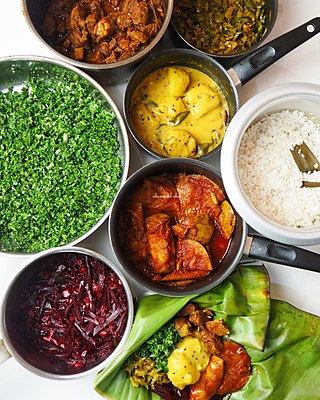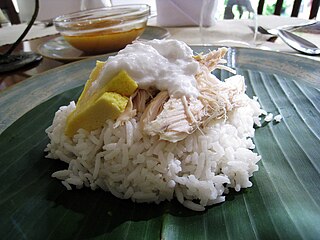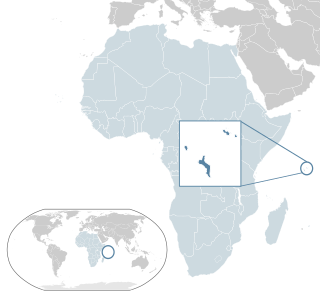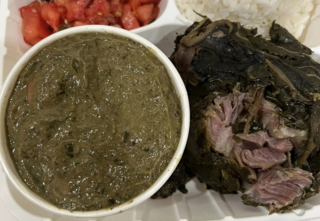This article has multiple issues. Please help improve it or discuss these issues on the talk page . (Learn how and when to remove these template messages)
|
 Kokoda, raw fish served in a coconut. | |
| Country or region | Fiji |
|---|---|
| National dishes | Curry, lovo |
| National drink | Kava |
| See also | Indo-Fijian cuisine |
Fijian cuisine has long consisted of primarily foraged and farm-grown food. Although rice, wheat, and tea all became staples during Fiji's colonial era, native Fijians still eat primarily tubers and coconuts. The cuisine of Fiji is known for its seafood and various green vegetables, including ''ota'', a young forest fern, and ''bele'' ("slippery cabbage"), a plant that resembles spinach.
Contents
- History
- Snacks
- Ingredients
- Staples
- Vegetables
- Coconut
- Dishes
- Main
- Desserts
- Drinks
- Kava/Yaqona
- Changes in eating patterns over time
- Fast food
- See also
- References
Fiji's recent past as a colony of the British Empire has had significant impact on its cuisine, as the British indentured servitude system brought many Indians to the islands and substantially shaped the cuisine into what it is today.
In many homes, breakfast includes regional dishes like roti and curry, boiled taro and fish soup, and cabin crackers with butter in addition to goods like bread, cereal, milk, tea, and coffee. The diet is comparable to that of neighbouring island countries like Samoa and Tonga. A wide range of food is available thanks to the old trade routes that span these nations.
Meats like chicken and lamb are very popular, whereas cattle and pork are reared for special occasions like weddings and purchased young. Lamb and chicken sausages, as well as eggs, are frequently the least expensive sources of protein in homes. Many people get their protein mostly from seafood, and many children enjoy going fishing for an entire meal. Due to numerous indigenous peoples living along the coast, freshwater and marine prawns, mussels, clams, sea urchins, sea cucumbers, oyster, lobster, fish, crabs, octopus, and squid have been the main source of nourishment for many years.
For many years, turtle was also eaten; however, due to changing habits and dwindling populations, the Fijian government has heavily restricted or forbidden the consumption of many endangered species. Sharks are never consumed as they are believed to represent the sea god Dakuwaqa and are therefore taboo. To kill or eat a shark is believed to bring great misfortune on the village.
Coconut milk, sea water, Indian spices, onions, carrots, garlic, ginger, limes, lemons, curry leaves and chili are also the primary flavorings, with Chinese influences from soy and oyster sauce being popular additions.
Lunch in the villages consists of a steamed starchy item such as cassava or taro, a soup and tea, sweetened with cane sugar. Indo-Fijian families may stick to traditional rice, dhal and either a meat or vegetable curry accompanied by a salad or chutney. Masala tea is the main drink in many Indo-Fijian households. Many city people however are turning to easily available western fast foods which are now becoming a popular choice for the younger generation.
Dinner is usually something elaborate and meat based, such as stews, soups, curries, stir fries and even traditional earth oven food called lovo (similar to an umu or hangi) This is usually served with a simple salad and rice or root vegetable to bulk up the meals. Fijian diets are also based on foraged items such as forest ferns and wild herbs which are now readily sold in food markets. Herbs such as coriander and mint are highly used to flavour both sweet and savoury dishes. Tinned goods are pantry basics and include favourites such as tinned mackerel, sardines, tuna, baked beans, corned beef, corned mutton and condensed milk. Dessert dishes include a steamed coconut pudding, a dense cake similar to spotted dick but flavoured with cardamom, ginger, condensed milk, coconut milk and sugarcane syrup. This cake is a well loved classic with many families eating it either hot or cold, spread with butter. Another popular dessert is vakalolo made with grated cassava, ginger, sugar, cardamom and coconut milk. The mixture is shaped into small, flat pancakes, wrapped in banana leaves and steamed. A dense, chewy and sweet dish, vakalolo has incorporated many Indian spices to enhance the flavours.
A very common feast is the lovo, where food is wrapped and cooked for several hours on hot stones covered with earth and sacks. Similar to the NZ hangi, the Fijian style of lovo uses soy sauce, garlic, chilli and ginger as flavourings for meat. Fish are usually steamed in taro leaves with onions, garlic, chilli and coconut milk called Fish-in-lolo. Another common lovo item is palusami, of which a vegetarian and non vegetarian type are both popular additions. Consisting of young, tender taro leaves, coconut milk, ginger, garlic, chilli, lime juice, salt and may include corned beef/mutton or fish, palusami is also a staple menu item along with rourou, a similar taro leaf dish. Yams, cassava and taro are the main starches in a lovo and it takes many people to prepare hence its special significance.



















